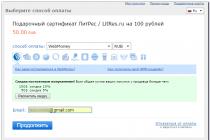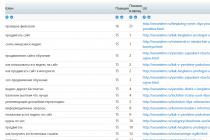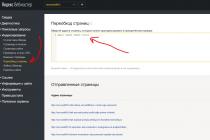What is Trados?
Trados is a special software product that belongs to the family of so-called. TM programs. TM programs allow you to accumulate and use when translating the current document a special database created by the translator himself in the course of his previous translations - a memory bank of past translations or, in short, translation memory (TM).
Trados Studio - a software package for translators
Trados has three main components. First, this workspace. Those. a translator working in Trados opens a document in a different Microsoft Word or Excel, it opens the file in a special shell, in which, perhaps, there is not much of what is in Microsoft Office, but there are various functions that are useful in the implementation of the translation. Second, Trados contains two types of databases. One database is the same "translation memory" that can remember everything that the translator is currently translating. Another database is the term store or MultiTerm. In this database, the translator can enter individual terms and their meaning, some explanations and even pictures.

Why you need Trados
For translator
Initially, upon purchase, Trados is empty. Those. it contains everything you need, except for the "most important" for the uninitiated - there are no dictionaries, ie. not at all. When buying Trados, a translator spends thousands of dollars not at all to buy some secret dictionary that cunning but greedy translators have, but ordinary citizens and "poor" businessmen do not.
But the translator has clients. Which, as a rule, are customer firms or translation agencies. What does this mean for the translator? And this means a stream of similar documents that he must translate. But what does "similar" mean? In this case, this means that the company the translator works with has some sort of established terminology and has standard materials. Which can be repeated, with variations, of course, even with big changes, but sometimes for years. In addition, the firm concludes contracts and conducts correspondence with partners. Of course, the agreements and partners are different, but they definitely have something in common. In short, for a translator, a customer is a set of characteristic phrases and special terms that, perhaps, are accepted only in this small segment of the market, but without understanding which outsiders have nothing to do in this market.
Accordingly, the translator has two tasks: firstly, to translate the material as accurately as possible (let me remind you that a translator usually has several customers; some can place an order once a year, for example; accordingly, you can forget by the next order that you were there once translated), and secondly, to make sure that repeating pieces of this material would also be repeated during translation. Otherwise, you will agree, it would be somehow indecent to translate today like this, and tomorrow like that.
That is why the translator buys and uses special TM programs that allow him, firstly, to quickly remember, even in small things and nuances, the specifics of his client, and secondly, to translate similar pieces of text as closely as possible. Trados can significantly speed up and improve the quality of translation work: there is no need to painfully remember where you found the meaning of a particular term last time (and even not find this meaning this time), and you can quickly insert the translation into repeated places. So the cost pays off over time.
For translation agencies
Translation agencies also have problems. It would seem that you say and say to customers that a translator is a person, he cannot physically translate more than 10-12 pages of text per day, and the customers seem to have agreed: take it out and put it on for everyone, from 100 pages to infinity, and preferably "yesterday" . At the same time, in words, customers are ready to agree with "some reduction in the quality of translation", because in order to translate this voluminous document in a short time, several people need to be involved in its translation at once (and each of them has his own characteristics, his own understanding and his own style). But for some reason, sometimes, over time, of course, but it turns out that the customer is not satisfied with the quality of the translation and this very urgent order, and he cannot understand how the same term (or phrase) in one place is translated as in a different way. Even if the entire translation is generally correct, but why such a discrepancy, where did all these synonyms come from? It is clear who is extreme in such situations.
And that's why the translation agency also buys Trados. Only a more complex (and expensive) version of it. To connect their translators to a single database so that they can download a single terminology, translate the same pieces of text in the same way, and generally talk and discuss a single strategy for translating this material.
How translation looks like with Trados
For translator
So the order has been received. If it is a new customer, the translator creates a "project". Which is initially as empty as Trados at the time of purchase. Then, being in the "project", the translator opens the file to be translated and starts its work. Trados remembers sentences. And if there are at least two identical sentences in the new document, the translation needs to be done only once, and it will be inserted into these two places at once. But that is not all. Trados will simultaneously "remember" the translation of this offer in the database for this customer. Those. if this sentence occurs in a new document from the same customer, it will already be inserted as translated. In addition, Trados will mark with a special designation all "similar" offers, i.e. those where there are almost all the words that are in the sample sentence, but there may be other words that are not in the sample. Those. in fact, in the case of a high degree of similarity, the translator will only have to translate a piece of the sentence, sometimes even one word.
In this case, the database can be adjusted. Suppose this term was translated like this, but suddenly the customer came to the conclusion that it should be translated differently. No problems! A small adjustment of the database, and all the following translations will go in a new way. Here's an example for you. What phone do you have, cell or mobile? Think about it, now it is rather mobile. But 10 years ago it was more like a cell phone. So, in the case of Trados, no tragedy happened, and the old databases, having been slightly tweaked, can still be used.
Finally, the work with the file for the new customer is completed. The translator will convert this file back to word document, Excel or PowerPoint, and also saves new base information for this customer. The next time this client calls again, the translator is a little better prepared for the job. Everyone is satisfied. The translator is satisfied, he works faster and better (and can focus on the most difficult areas). Satisfied customer, he receives high-quality and improving day by day translations.
For translation agencies
Believe it or not, the main headache of any translation agency is where to find the right number of translators. Suppose you have been successfully working in the translation services market for a long time. You have regular customers. Permanent translators are also "attached" to regular customers. Which on this topic "ate the dog." But these regular customers are very fickle. Today he is doing well, but tomorrow - you look - he will wither. And the other for years sent orders for three kopecks, and suddenly something unimaginable began with him: he drives and drives the shaft, do not breathe. Therefore, there are a lot of "attached" translators, or they are wildly lacking. And the trouble lies elsewhere: there are people, specialists, professionals, but, unfortunately, they have never worked in this subject, in this segment. So, if they start, they will break firewood out of habit. And what to do? To put the main "specialist" in charge of the team of "beginners"? Does he want it? Can he do it? And if there is one, well, a very important document in the package of documents, which should be translated by a "specialist", because it is according to this document that the customer will evaluate the quality of work (hehe, he says so now!).
There is a way out, and it's called Trados. As you remember, Trados is a translation memory, first of all. And this memory can be "disconnected" and sent to everyone who needs it. In addition, Trados is a memory of terms. Which can also be "detached" and sent to colleagues. Thus, if our translator - "chief specialist" previously worked in Trados, he can transfer his databases to the entire team of translators, and they will no longer work from scratch, they will have the opportunity to quickly navigate the terminology and even, if they are lucky, in the process his own translation, "unexpectedly" to see in his place already "someone" translated places and catch the style of translation.
Now let's imagine that a translation agency has a special, expensive Trados that allows you to centrally manage all databases. Let's say the command is running. This means that each member of the team can almost immediately see how one or another piece was translated by his colleague. He can correct it immediately (if needed), and he can take advantage of the work of others (remember, Trados inserts the translation in all places where it matches 100 percent, and in addition, marks those places where the match is, say, 80 %, i.e. the sentence differs by one word or a short phrase).
So everyone is happy again. The customer is satisfied, his wish - to translate a large amount of material in a short time - has been fulfilled and fulfilled on high level. The translator is satisfied, because he made good money, even on unfamiliar material (which in other conditions is given with great difficulty and, of course, subjectively it seems that it is poorly paid at first). The translation firm is happy because who do you think the database is? That's right, it's company property. We kill two birds with one stone: you can additionally tie the staff to yourself, you can, and, if necessary, connect a new staff. But there is also a third "hare". Let's suppose that a competitor has "interrupted" a tender for translations to a given customer from our company. Well, why not sell this very database to "villains" competitors? At least some benefit.
Translation cats, like ordinary ones, are different. I will talk about the CAT tool that I use and which is the most popular.*
Trados is an automated translation tool. This means that the program does not translate for you, but only helps to optimize the translation process, which sometimes significantly speeds up the work. This is achieved due to the fact that Trados allows you to accumulate a database of already translated texts ( Translation Memory ) and use it to translate subsequent texts.
(Company homepage: http://www.trados.com/en/)
This article is for those who hear about this program for the first time and want to get an idea of how it works.
You will see that Trados not as scary as it might seem.
To work with it, it is enough to know three keyboard shortcuts (for starters).
An example of working with SDL Trados 7 Freelance.
When you translate a document MS Word, you have the source document itself and an additional window open Trados - Translator's Workbench. I placed the window Translator's Workbench to the right of the window MS Word, and there is still room for two dictionaries (see the figure below).
As you can see, I have prepared the file MS Word A containing several similar sentences. The first and last sentences are identical.
Place the cursor at the beginning of the first sentence and press first keyboard shortcut:
Alt+Home
We get the following picture:

Look at the window first MS Word. The first offer "opened" in the blue field. A yellow field has opened below - here we will print the translation.
Now look at the window Translator's Workbench. It is divided into two parts. The top one shows the sentence you are currently translating, the bottom one is empty. This means that there is no such sentence in your translation memory yet.
Let's print the translation.

Let's move on to the next proposal. For this, it is used second keyboard shortcut:
Alt+Num+ Ctrl+Alt+N(for laptop).
Let's see what happened:

First, look at what happened to the first translated sentence. Both the original and the translation are visible, while they are enclosed in "tags" ( Special symbols- they are needed by the program).
Now let's look at the second proposal. The original text has opened in a blue field, and below it, in a yellow field, a translation has already been suggested. It means that Trados found a similar sentence in the translation memory and substituted its translation.
In the window Translator's Workbench the lower section shows which translation memory sentence the variant came from. The word highlighted in yellow is the one that distinguishes the two sentences. Those. there is a word in our sentence "another", and in the previously encountered sentence, the article was in its place "a". This is especially useful if the sentence is long and only one word needs to be corrected.
We will correct the translation accordingly.

We press the already familiar keyboard shortcut to go to the next sentence:
Alt+Num+(for standard keyboard) or Ctrl+Alt+N(for laptop):

The situation repeated itself - the previous offer was closed with tags, a new one was opened. And again we are offered a translation.
We look out the window Translator's Workbench. One word is highlighted in grey. This means that we are offered a translation of a sentence that has already been met before, but the new sentence has one more word (highlighted in gray). Let's add the translation of this word in the yellow field:

Alt+Num+(for standard keyboard) or Ctrl+Alt+N(for laptop)

And again we were lucky. A translation of a similar sentence has already been suggested in the yellow box.
We look out the window Translator's Workbench. One word is highlighted in blue. This means that we are offered a translation of a sentence that has already been met before, but in the new sentence one of the words is in a different place (highlighted in blue). Correct the translation in the yellow field:

Let's move on to the next offer:
Alt+Num+(for standard keyboard) or Ctrl+Alt+N(for laptop):

This is the dream of every translator!!!
As before, the original sentence opened in a blue box, and below it, a translation in a green box. Green color means 100% match. As you remember, I made the first and last sentences identical.
Thus, nothing needs to be edited in the proposed translation. We already have the correct translation ready! Since this is the last sentence, we do not move on to the next one, but close this segment with a keyboard shortcut:
Alt + End

All segments are ready. Now in a split second with Translator's Workbench clear the file and get a clean file with translation:

Well, who's to say that this is a complex program?
You have seen that it is enough to know just three keyboard shortcuts:
- Alt+Home
- Alt+Num+(for standard keyboard) or Ctrl+Alt+N(for laptop)
- Alt + End
For starters, and in most cases, you don't need more.
Especially useful Trados when translating texts that contain repetitions or similar sentences. For example, it is a pleasure to translate instructions for different versions digital cameras from the same company, etc.
But even if there are few repetitions, it is still more convenient to work with this cat. You have separate fields for each original sentence and its translation, you won't miss a single sentence, and so on.
There are also disadvantages.
For example, working with this program ties you to work by sentences, and sometimes it is better to read a whole paragraph and then convey its meaning, although in most cases we still translate by sentences.
So, the principle of work is clear to you.
There are little things left. However, without them, you will not be able to get to work and get the desired result.
Just as briefly, I will tell you everything you need to know to work with this program, and also share some tricks.
_________________________
*Question of popularity Trados requires special consideration, which we will deal with later.
Let's analyze the advantages of working with Trados from the side of a translator
There are clients for whom one of the main requirements is to work in the Trados system, but there are still not many such clients with these requirements, mainly large global or foreign companies with a constant flow of documentation for the translation of large volumes.
But, many professional translators use Trados not only when it is the client's requirement, but when performing each translation. What for? Those. translation in Trados is considered not as a tool for working with certain clients, but as a tool that facilitates the work of a translator with the highest quality of translation. Many translators use trados whether the client requires it or not. Today, only 10-15% of our agency's clients are required to use Trados, while the rest simply need a quality translation.
How it works in the Trados system
The concept of working in the Trados system involves identifying fragments in the translated text, the translations of which are already available in the database of our agency. Thanks to the experience gained by our agency since 1996, an extensive database has been formed in various thematic areas, which always allows us to complete translations in a short time without loss of quality. The database is updated almost daily.
Benefits of working with Trados on the client side
From the client side, there are 2 significant advantages of working in the Trados system.
The first is to always receive a high-quality translation in compliance with all the terminology that is used in each order.
The second is the optimization of translation costs, since the translation is accounted for based on the number of new words and repetitions that have already been entered into the database.
This system works with constant volumes of the same type of documentation.
Many clients, when working with the Trados system, provide their base, which is successfully used by our specialists with the same goals: quality and cost optimization.
Our agency will be happy to help you with professional translation in various language and subject areas.
We look forward to collaborating!
our clients
OJSC "" is the leading vertically integrated oil company in Russia. The main activities of the company are exploration and production of oil and gas, production and sale of petroleum products. The company plays a key role in the Russian energy sector, accounting for more than 19% of Russia's total oil production and 19% of Russia's oil refining. As of the end of 2003, the company's sales network covered 17 countries of the world and in Russia alone included 10 oil product supply organizations operating in 60 subjects of the Russian Federation.

Company - leading system integrator, specializing in the development, construction and technical support of corporate data transmission systems, system integration, consulting, technical support and training, distribution of telecommunications equipment and software.
The company carries out a full cycle of works on the construction of telecommunication systems and communication systems: design, supply, installation, commissioning and Maintenance and operation of the systems.
The Race company operates throughout the Russian Federation and the CIS countries. During its work, the company has acquired a significant number of partners from among domestic and foreign firms. Geographically, these firms are located throughout the CIS countries.

Company Federal State Unitary Enterprise "InformVES, Trade and Investment Promotion Agency", providing services in the field of property, administrative, personnel services. The company is engaged software tools mi database management systems (DBMS), Software tools for object-oriented databases, software tools for developing databases on CD-ROMs, services in the field of electronic (computer) data processing.
It is difficult to overestimate the contribution of computer-aided translation systems, which have become especially widespread in recent years. However, there is a lack of information, including in Russian, with descriptions of the most common products for automated translation and their purpose. This article attempts to give short description software products automated translation company Trados.
SDL Trados™
Trados Translator's Workbench Module
Module translator"sWorkbench implements the main functions of Translation Memory (TM ), by storing completed translations in Translation Memory, the user of the TRADOS system increases the efficiency of subsequent projects.
Translator's Workbench (also Workbench) is a database system that stores translation units. Each translation unit (TU) consists of a source segment and its translation.
WinAlign Module

Module WinAlign is designed to replenish the Translation Memory by processing already completed translations (those translations that were completed before the TRADOS program appeared at the user's disposal).
WinAlign allows you to create translation memories by linking segments of text and the finished translation. To do this, WinAlign first analyzes the texts in the source and target languages, and then links the individual source and target segments, thereby creating translation units. The user views the results of this synchronization and then saves the result as a text file for import into Translator's Workbench.
TagEditor module

ModuleTagEditor allows you to translate HTML/SGML/XML, tagged files and perform text preprocessing. Can work with Excel and Power Point. TagEditor translates documents in HTML, SGML, XML, ASP, JSP formats. TagEditor includes an XML Validator that guarantees more precise formatting when working with XML files.
TRADOS Freelance
Version TradosFreelance designed for freelance translators.
There are limitations compared to Classic TRADOS TM Solution and TRADOS Language Service Provider - TRADOS Freelance does not support shared TM storage.
TRADOS Freelance includes the following modules:
- Translator's Workbench: with restrictions on supported languages. The user can only work with 5 languages, which are selected from the general list at the installation stage. There is no possibility of allocating HM for the project.
- TagEditor: no limits.
- T-WindowCollection: no limits.
- WinAlign: restrictions: 5 languages and up to 10 pairs of files in a project.
- MultiTerm Workstation: no limits.
SDL Trados Multiterm

MultiTerm represents modern system management of Trados terminology. The main terminology management interface is MultiTerm. Through this interface, users can create term databases, add and edit terms, view the term database, search, filter, and export data. MultiTerm can be used as a standalone system with a local terminology database. In addition, MultiTerm can be used as a client application in a multi-user environment, connected to remote or network term databases, for which you have the appropriate access rights.
Multiterm Extract Component

Retrieves and displays a list of potential terms and their likely translations. This allows you to retrieve terms from monolingual or bilingual documents, as well as from translation memories. In the MultiTerm Extract interface, you can quickly and easily check the extracted terms. You can use a large number of export options to include the extracted terms in existing TRADOS MultiTerm termbases or export to MultiTerm XML or tab delimited format. You can also check the consistency of terminology between the termbase and the translated file.
TRADOS MultiTerm Server
This server solution greatly simplifies terminology management.
Trados MultiTerm Server provides the ability to access and disseminate terminology via the Internet or Intranet.
MultiTerm Workstation is a toolkit for working with terminology locally.
The user can add terminology to the base "on the fly" without interrupting his translation in Word.
SDL TradosTM Server
TM Server allows you to place the Translation Memory database on a server and provide access to this server via the Internet/Intranet. The solution is based on a scalable client-server architecture that supports Microsoft SQL Oracle server and databases on Windows and Unix platforms. TRADOS™ Server. it is a system that meets the most stringent requirements of the modern translation process. With the help of TM Server, a highly efficient use of a TM database of practically unlimited sizes is ensured. TM Server handles tasks with tens of thousands or millions of TUs equally quickly, regardless of whether 2, 20 or 200 users access the database at the same time.
InstructionDocument translation in SDL Trados Studio 2019
"Document translation in SDL Trados Studio 2019.pdf", SamplePhotoPrinter.docx document, printer.sdltm translation database, Printer.sdltb terminology dictionary.
Download and unzip the archive on your computer. Launch SDL Trados Studio 2019 and start translating the SamplePhotoPrinter.docx document by following the instructions.
Toolkit Translation in Studio 2017 file in 10 simple steps
The document in a simple and visual form shows the steps required in order to translate in SDL Trados Studio 2017 (Russian interface)
Instruction
Instruction Studio 2017, Comparison: Creating a Translation Memory from Previously Translated Documents
The archive contains: step by step instructions Studio 2017 Mapping.pdf, as well as documents And .
Download and unzip the archive on your computer. Launch SDL Trados Studio 2017 and follow the instructions to create a merge project.
Instruction
InstructionInstallation and licensing of the SDL Trados Studio 2017 Freelance system
An overview of the main stages of installing SDL Trados Studio 2017 Freelance: obtaining a license, downloading SDL Trados distributions, installing, (de-)activating a license.
InstructionInstalling and Licensing SDL Trados Studio 2017 Professional Single-User
An overview of the main stages of installing SDL Trados Studio 2017 Professional Single-User: obtaining a license, downloading SDL Trados distributions, installing, (de-)activating a license.
InstructionInstalling and licensing the SDL Trados Studio 2017 Professional system in case of using network licenses
An overview of the main stages of installing SDL Trados Studio 2017 Network: obtaining a license, downloading SDL Trados distributions, installing, activating a license on client machines and the server part.
Toolkit Translation of a file in 10 easy steps
The document shows in a simple and visual way the steps required to perform a translation in SDL Trados Studio 2015 (English interface)
Instruction Document translation in SDL Trados Studio 2015
The archive contains: step-by-step instruction "Translating a document in SDL Trados Studio 2015.pdf", SamplePhotoPrinter.docx document, printer.sdltm translation base, Printer.sdltb terminology dictionary.
Download and unzip the archive on your computer. Launch SDL Trados Studio 2015 and start translating the SamplePhotoPrinter.docx document following the instructions.
Instruction Studio 2015, Collation: Create a Translation Memory from Previously Translated Documents
Archive contains: step by step instructions Studio 2015 Mapping.pdf, as well as documents Translating and Reviewing Documents QSG_en.docx And Translating and Reviewing Documents QSG_en.doc.
Download and unzip the archive on your computer. Launch SDL Trados Studio 2015 and follow the instructions to create a federation project.
Management SDL Trados Studio 2015: Quick Guide to Translation and Editing
Management SDL Trados Studio 2015: Quick Guide to Translation Memory Management
Intended for users who create and maintain translation memories. It deals with setting up translation bases, searching and editing translation units in manual and automatic modes, data import into translation databases.
Management SDL Trados Studio 2015: Quick Guide to Project Management
Aimed at project managers. It considers life cycle project, starting with the creation of a project, and then managing this project using packages.
InstructionInstallation and licensing of the SDL Trados Studio 2015 Freelance system
An overview of the main stages of installing SDL Trados Studio 2015 Freelance: obtaining a license, downloading SDL Trados distributions, installing, (de-)activating a license.
InstructionInstalling SDL Trados Studio 2015 Professional Single User
An overview of the main stages of installing SDL Trados Studio 2015 Professional Single-User: obtaining a license, downloading SDL Trados distributions, installing, (de-)activating a license.
InstructionInstalling and Licensing SDL Trados Studio 2015 Professional (Network)
An overview of the main stages of installing SDL Trados Studio 2015 Network: obtaining a license, downloading SDL Trados distributions, installing, activating a license on client machines and the server part.
Instruction Document translation in SDL Trados Studio 2014
The archive contains: step-by-step instruction "Translating a document in SDL Trados Studio 2014.pdf", SamplePhotoPrinter.docx document, printer.sdltm translation base, Printer.sdltb terminology dictionary.
Download and unzip the archive on your computer. Launch SDL Trados Studio 2014 and start translating the SamplePhotoPrinter.docx document following the instructions.
InstructionInstallation and licensing of SDL Trados Studio 2014 Freelance system when upgrading from earlier versions
Overview of the main installation steps for SDL Trados Studio 2014 Freelance when migrating from earlier versions: obtaining a license, downloading distributions of SDL Trados, installation, operations related to licensing.
Instruction Installation and licensing of the SDL Trados Studio 2014 Freelance system
An overview of the main stages of installing SDL Trados Studio 2014 Freelance: obtaining a license, downloading SDL Trados distributions, installing, (de-)activating a license.
InstructionInstalling SDL Trados Studio 2014 Professional when using single user licenses
An overview of the main stages of installing SDL Trados Studio 2014 Professional Single-User: obtaining a license, downloading SDL Trados distributions, installing, (de-)activating a license.
Instruction Installing SDL Trados Studio 2014 Professional when using network licenses
An overview of the main stages of installing SDL Trados Studio 2014 Network: obtaining a license, downloading SDL Trados distributions, installing, activating a license on client machines and the server part.
Instruction Studio 2014, Alignment mode of operation: creating a translation memory based on previously translated documents
Archive contains: step by step instructions Studio 2014 SP1. Merging previously translated documents.pdf, the documents Translating and Reviewing Documents QSG_en.docx And Translating and Reviewing Documents QSG_en.doc.
Download and unzip the archive on your computer. Launch SDL Trados Studio 2014 and follow the instructions to create a merge project.
SDL Trados Studio 2014: Quick Guide to Translation and Editing
Intended for translators and reviewers. It deals with the translation and editing of translated documents. These documents can be presented as single files for translation or as files as part of a project or subproject (package).














